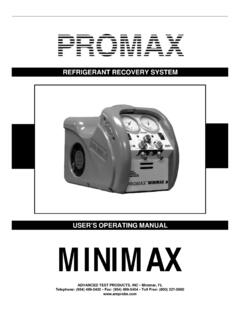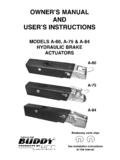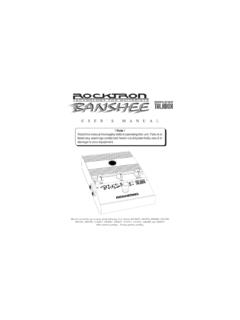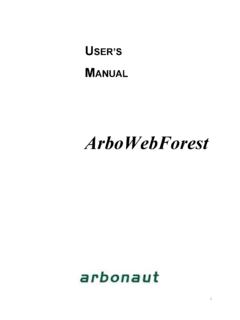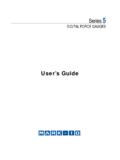Transcription of USER’S OPERATING MANUAL RG5410A - Brushes …
1 RG5410 AREFRIGERANT RECOVERY UNITUSER S OPERATING MANUALADVANCED TEST PRODUCTS. INC Miramar, FLTelephone: (954) 499-5400 Fax: (954) 499-5454 Toll Free: (800) :TABLE OF CONTENTSIMPORTANTSAFETYINFORMATION4 OPERATING GUIDELINES5-6 CARE AND MAINTENANCE OF YOUR RG5410A6 ADDITIONALRECOVERY TANK INFORMATION7 PURGING NON-CONDENSABLE GASES 8 HELPFULHINTS FOR REFRIGERANTRECOVERY9-10 OPERATING YOUR RG5410A11 DIAGRAM FOR REFRIGERANTRECOVERY11 SELF PURGING YOUR RG5410A12 SELF PURGE/AUTO EVACUATE12 DIAGRAM FOR PUSH/PULL METHOD13 SET-UPDIAGRAM FOR TANK PRE OR SUB COOLING PROCEDURE13 OPTIONALRECOVERY / TANK PRE OR SUB14 COOLING FOR FIXED HOSE SET-UPREFRIGERANTFLOW DIAGRAM15RG5410 APARTS DIAGRAM/PARTS AND ACCESSORIES LIST16RG5410 AWIRING DIAGRAM17 INSTALLATION OF OPTIONAL80%
2 TANKCAPACITYSENSING COMPONENTS (KITKT-50001) RG5410A -KTMODEL18 TROUBLESHOOTING YOUR RG5410A19 FULLONE YEAR WARRANTY20 ENVIROMENTALPROTECTION AGENCY(EPA) instructions 21 EPAREGIONALOFFICES 223mIMPORTANT SAFETYINFORMATION mSAFETYCOMES FIRST! Read all safety, operatingguidelines and instructions before OPERATING CAUTION: ONLY AQUALIFIED TECHNICIAN SHOULD OPERATE THIS operator must be familiar with air conditioning and refrigeration systems, refrigerants and the dangers of pressurized components. 2. Always think before acting, familiarity breeds care-lessness and carelessness can be harmful to your health or, worse, result in mWARNING Always wear safety goggles and protective gloves when working with refrigerants.
3 Contact with refrigerant may cause hoses with extreme caution! All hoses may contain liquid refrigerant under mPRESSURIZED TANK CONTAINS LIQUID REFRIGERANT. NEVER OVERFILLSTORAGE TANKS. OVERFILLING OF THE TANK MAYCAUSE AVIOLENTEXPLOSIONANDPOSSIBLE INJURYOR :Exceedtheworking pressure of Recovery Tank : DO NOT: Exceed the working pres- sure of each cylinder. Recovery cylinders are RG5410 Ais not supplied with a recovery tank, it requires the use of tanks with a minimum of 350 psi working pressure and PROMAX strongly recom-mends the use of 400 psi : The use of a 400 psi tank is mandatorywhen recovering PROMAX Recovery Tanks under Parts and Accessories section on Page must be used to avoid overfilling the storage tank.
4 DO NOTOVERFILL. Tank is full at 80% volume. Tank may explode if filled more than 80% due to liquid ONLY authorized refillable refrigerant tanks. NEVER use a standard disposable 30 lb. tank (thetypeofcontainerinwhichvirginrefriger ant issold) to recover all safety information regarding the safe handling of refrigerant and refrigerant oil, includ- ing the Material Safety Data Sheet. MSDS sheets can be obtained from your refrigerant If you expect temperatures in excess of 135 F,contact the refrigerant Be sure that any room where you are working is thoroughly ventilated, especially if a leak is sus-pected.
5 Refrigerant vapor is hazardous to your health and can cause mAvoid breathingA/Crefrigerantandlubrica- tion vapor or mist. Exposure may irritate eyes, nose and throat. If accidental system discharge occurs,ventilateworkareabeforeresumingse rv-ice. :TOREDUCETHERISKOF FIRE: Neveroperateunitinanexplosiveenvironment ! Do not use this equipment in the vicinity of spilled or open containers of gasoline or any other flammable liquid. When using an extension cord it should be a 3-wire, 14 AWG minimum and no longer than 25 feet. Usethisequipmentinlocationswithmechanica l ventilation that provides at least four air changes per hour or locate the equipment at least 18 inches above the floor.
6 Never use oxygen when testing for leaks. Any oil in contact with oxygen under pressure will form an explosive cHigh voltage electricity inside panels. Risk of electrical sure to disconnect theunitfromthepowersourcebeforeservicing reduce the risk of injury, care should be taken when moving this OPERATING the RG5410 Arecovery unit, read the following m1. RG5410 AIS APPROVED FOR USE WITH THE FOLLOWING CATEGORYIII, IV and V REFRIG-ERANTS (Per ARI 740):R-12, R-22, R-134A, R-401A, R-401B, R-401C, R-402A,R-402-B,R-404A,R-406A,R-407A,R-40 7-B,R-407C, R-407D, R-408A, R-409A, R-410A,R-411A,R-411B, R-412A, R-500, R-502, R-507 and R-5092.
7 AFILTER must alwaysbe used and should replaced frequently. We recommend that a clean filter be used for every service job. Failure to use a filter will invalidate your use of a filter will greatly reduce the risk of damage to your RG5410A , by preventing foreign material from entering the Each filter should be labeled and used exclusively for one type of refrigerant Always open service and cylinder valves allows rapid control of the flow of gases if there is any danger. Once it is determined that there is no danger, the valves can be opened Always isolate large amounts of refrigerant and close off valves after use, so if a leak should develop anywhere in the system, the refrigerant will not Keep all connections to the refrigeration system thoroughly dry and clean.
8 If moisture enters the refrigeration system, it is likely to cause consider-able damage. strongly recommends the use of the optional 80% Capacity Shutoff Kit (p/n KT-5001). When installed and used with a recovery tank that has an internal float switch, the RG5410 Awill shut down automatically when the tank is 80% full. Your RG5410 Ais pre-wired from the factory for this kit. Note: The RG5410 Ais also available in model RG541OA-KT, with the 80% Shutoff Kit installed direct from the mACAUTION: Use only authorized refillable refrigerant recovery tanks. Federal regulations require refrigerant to be transported only in containers meeting DOTspec.
9 4 BAor use a standard disposable 301b. ta, .1% (the type of container in which virgin refrigerant is sold) to recover refrigerant. 9. mAscale must be used to avoid overfilling the storage tank. DO NOTOVERFILL. Tank is full at 80% volume. Tank may explode if filled more than 80% due to liquid expansion. Below is a repre-sentative sample for R-22 refrigerant:Note: Promax strongly recommends the use of theADS-100 Refrigerant Scale for monitoring Your RG5410 Ahas two Internal Pressure Shut Off switches, a standard 400psi and a 550psi (when the High Pressure (R410A)switch is engaged). The shut off switches will automatically reset after the pressure drops below 200 : The Internal Pressure Shut OffSwitches do not prevent tank overfill.
10 If your systemshuts off on high pressure and is connected to yourtank, you may have overfilled your tank and createda very dangerous situation! Take immediate meas-ures to relieve any high pressure and/or tank When recovering large amounts of liquid, use the "Push/Pull method (see diagram on page 13). mCAUTION: When using the "Push/Pull" method,once the "Push/Pull" siphon is started, it can contin-ue and overfill the storage tank even if the tank isequipped with a "shut off" float siphoncan continue even after the machine is turned must manually close the valves on the tank andthe unit to prevent overfilling of the recovery operate the unit on a flat level To achieve the deepest final vacuum, use the tank cooling method to lower the head pressure on the recovery tank.
